A few days before the Unicode Consortium's annual conference was slated to begin, its co-founder and president Mark Davis had a change of heart. He canceled a planned session on local language formats and replaced it with a Q&A that seemed to hold much broader appeal: “Find out how…beneath a seemingly ordinary street in Zürich, deep in the vaults of Gringotts, a shadowy cabal meets to decide the future of emoji,” Davis promised.
I would meet this cabal. Along with my artistic collaborator Maggie Ronan, I had been invited to give a talk in the heart of Silicon Valley at the 39th Internationalization and Unicode Conference (IUC39), where the standards are set for the representation and encoding of all text in modern software. My talk would be on the implications of standardizing emoji, a linguistic system—partly represented in Unicode—in which ambiguity and elasticity are core features. On a Tuesday afternoon, Maggie and I drove from San Francisco to the vast, sprawling, and patriotically named streets of Santa Clara, CA. We parked at the Hyatt Regency hotel, whose loud swirling carpets would serve as backdrop for the Unicode royalty.
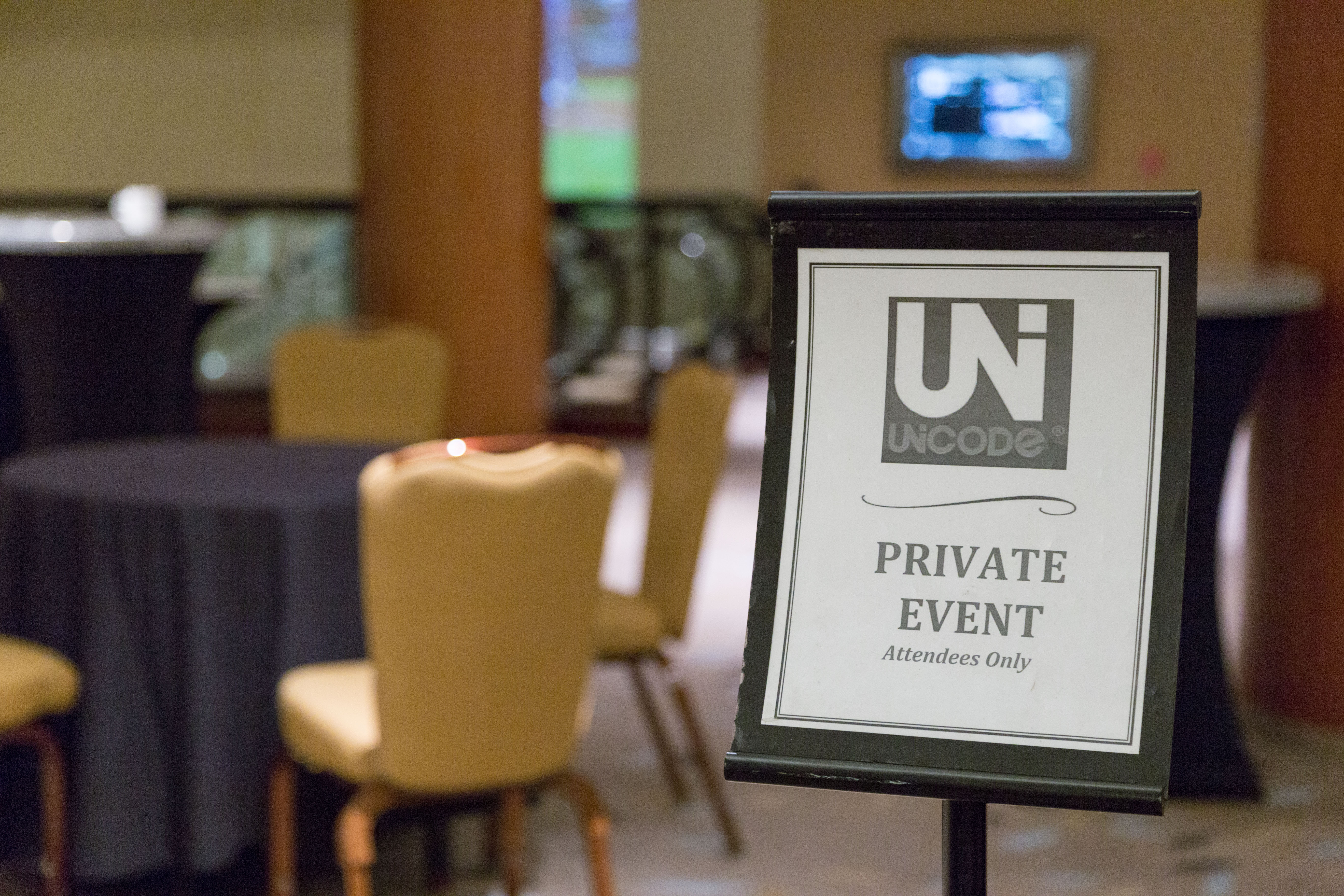
The 39th Internationalization and Unicode Conference, 2015. Photo by Liat Berdugo.
The Unicode Consortium defines how all mobile phones, desktops, and other computers represent the text of every language. Their decrees are published as the Unicode Standard—a compilation of information about the encoding and display of well over 110,000 characters that ensures consistency across operating systems of all kinds. It used to be that computers could not easily talk to one another, especially across different languages. Strings of bits that one computer system understands to represent "ABC" might well be rendered on another as something like “#!xx~.” Davis co-founded Unicode in the 1980s to solve this problem. Once Unicode was adopted, well, you could kiss your ASCII goodbye.[1]
“You made it just in time for the reception!” said the man behind the IUC39 registration table. He carefully affixed a red “speaker” ribbon onto my conference name badge, and fastened the lanyard around my neck. My name badge hung too low on my body—somewhere between my navel and my nether regions.
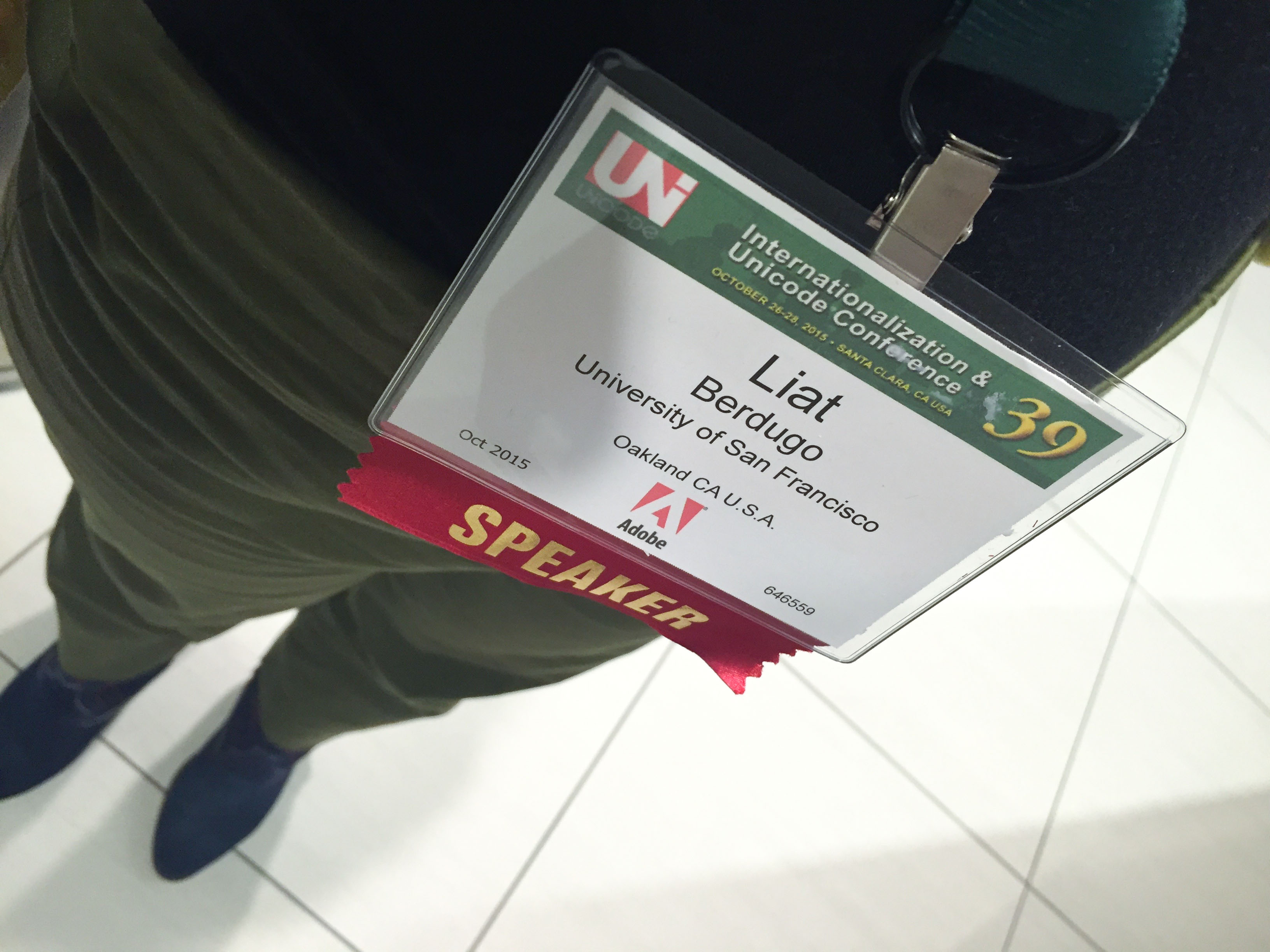
A badge made for bigger bodies, 2015. Photo by Liat Berdugo.
All around me, I began to notice bodies that were better suited to such a long lanyard; they all seemed to belong to engineers. Engineers from Microsoft, Apple, and Google. Engineers from Facebook, Twitter, and Yelp. Engineers from Intel, engineers from Blackbaud, engineers from Informatica. I found an outlier here or there: Debbie, for instance—a linguistics researcher at Berkeley who was standardizing Middle Egyptian hieroglyphics.
I was first in line for a glass of wine at the reception. I met an engineer named Craig Cummings while serving myself crudité. Cummings was a veteran of the Unicode conference, and sits on the Emoji Subcommittee as the resident naturalist (“I didn’t like the way that animals were being represented in emoji,” he confessed). He loved that I was a newbie, and told me stories of how Unicode once successfully got North and South Korea to sit down at a table to discuss standards. Another internationalization engineer named Russ Rolfe joined our conversation. Cummings explained that I was the only invited presenter who is an artist and curator, rather than a technology insider. “I am tickled to see you here,” Rolfe said. Tugging his hair, he added: “Because, you know: there is a graying at Unicode.”
Recently, Unicode has been getting a lot of press—and a fresh influx of pre-gray attendees, like me—for its mysterious role as the emoji gatekeeper. I’ll admit it: I am an emoji fanboy. I love them as cultural currencies of shared affective meaning.[2] I am wooed by poetic emoji text messages from lovers. I have two different pairs of emoji leggings that I got for $5 each at a corner store in east Oakland. I share a studio space with a company called 💾🌵(pronounced “Disk Cactus”), the first ever LLC registered with emoji. I type with an emoji keyboard on my computer at all times, for ease of access to 😂 and 🎈 and 👯👯👯. So I wanted to know: who chooses these characters? How do they decide what is included? And why do they get to choose?
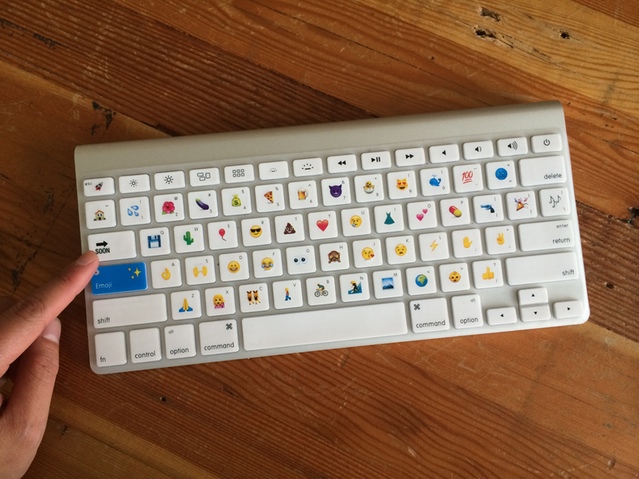
💾🌵’s Emoji Keyboard, 2015. Photo by 💾🌵/ diskcact.us
The Emoji Q&A Panel opened with a suggestion that its chair, Mark Davis, was dressed incorrectly for the occasion. Last Christmas his daughter made him a shirt that read “Shadowy Emoji Overlord” on the back.[3] “Yes, I should have worn that shirt,” agreed Davis. The other Shadowy Emoji Overlord, Peter Edberg of Apple, sat in the audience, out of the limelight. He matter-of-factly changed the subject: “OK, uh, questions?”
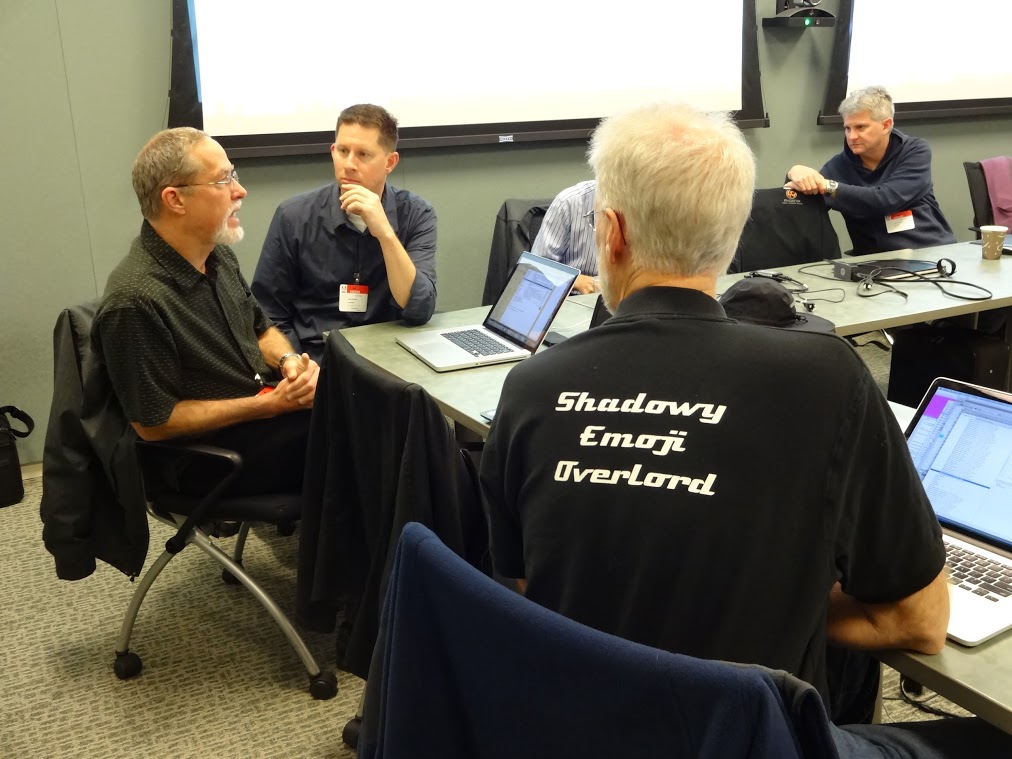
Mark Davis from behind at the Unicode meetings in May, 2015, with Peter Edberg sitting to his left. Photo retrieved from Davis's public Google+ account
“What is a common type of emoji suggestion that gets denied?” someone asked. “Justin Biebers, deities, and dead people,” answered Davis. Over the years, the Emoji Subcommittee has developed criteria for inclusion into the encoded standard—the most important of which is the expected level of usage. Once Unicode gives a candidate emoji a codepoint, it’s encoded forever, as if written in the blood of human-computer history. With that kind of commitment, Unicode understandably wants to know that they’re making the right choice. They want to pick the most popular emoji on the block.
I became obsessed with Unicode’s methodologies for determining emoji popularity. To my eye, their methods were poetic—more within the realm of conceptual art than engineering requirements. For instance, one way they determine emoji popularity is ask if a candidate emoji has high metaphoric potential: (SHARK) is not only an animal, but also a huckster, a card shark, a loan shark, and so on.
I encountered my favorite method for determining emoji popularity on the smartphone of Hiroyuki “Hiro” Komatsu, a Google engineer from Japan who was attempting get ten new food emoji passed at the Unicode Technical Committee’s meeting next week. He wanted emoji to contain characters for milk, pancakes, shrimp (but not the fried kind), and squid. His previous proposal hadn’t passed—he and I had corresponded about that process while he was in Japan—and since then, he’d been working with Mark Davis to rewrite it. “Mark suggested that I compare popularity to hamburger,” he said, and showed me his frequency analysis graph of the Google Image search trends of “MILK CARTON AND GLASS” as compared to HAMBURGER. I laughed. “Why hamburger?” I asked. “Because.... it’s popular!” Komatsu answered.
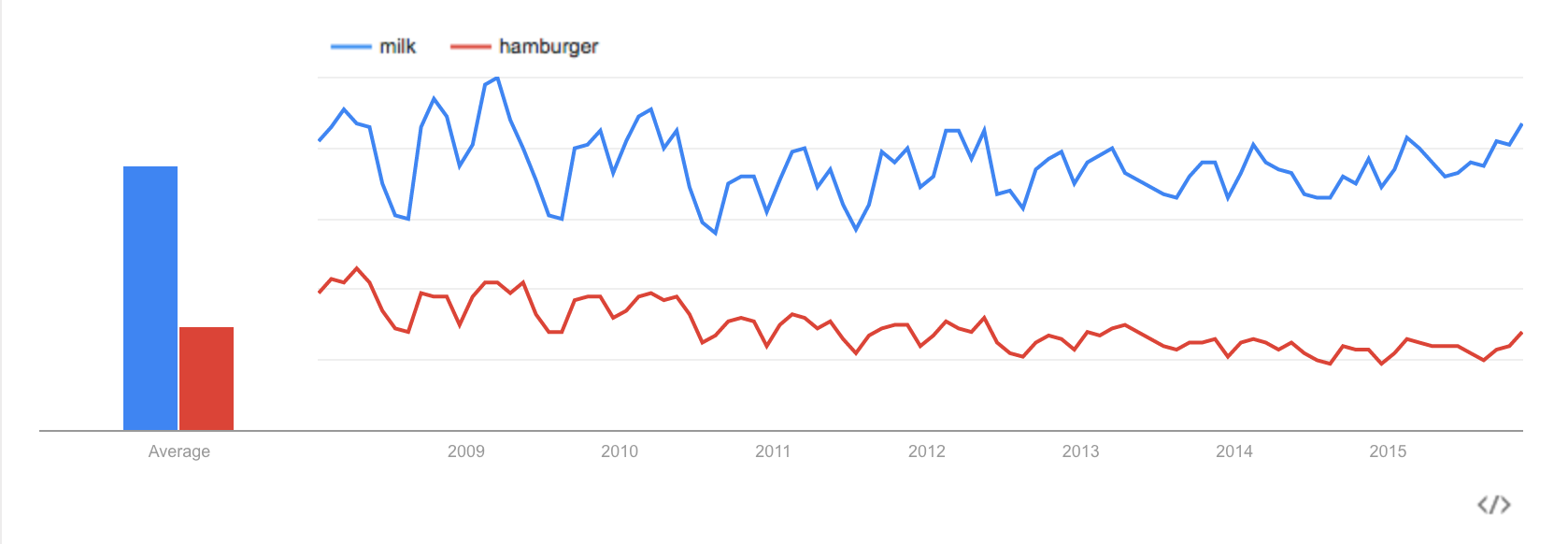
Google Image searches of milk carton and glass versus hamburger over time worldwide, Google Trends. The y-axis is relative Google Image search for the two terms (for instance, if at most 10% of searches were for "glass of milk," Google Trends considers this to be 100). This doesn't convey absolute search volume, but does show comparative search popularity over time.
Komatsu scrolled down on his phone. He scrolled, and I marveled to myself: I use 💩all the time, but never search for images of “pile of poo.” He showed me more graphs: “squid” compared to “hamburger” in English flat out loses. But in Japanese, squid's a winner.
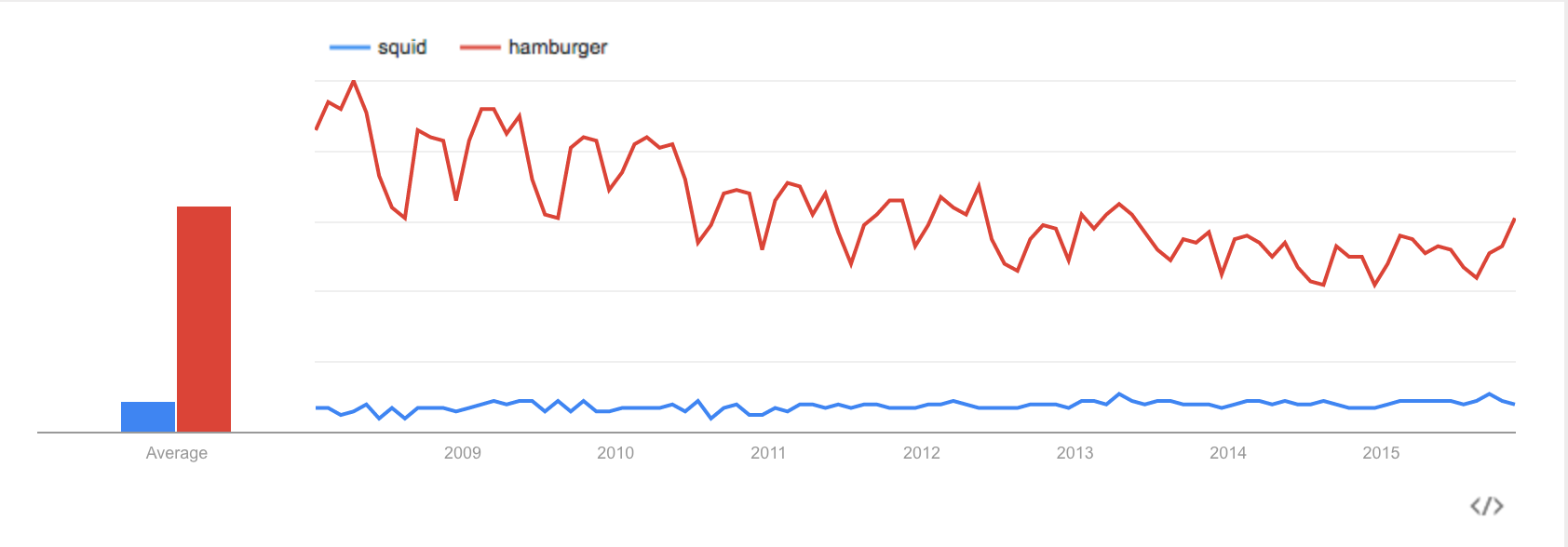
Google Image searches of squid versus hamburger over time worldwide, Google Trends.
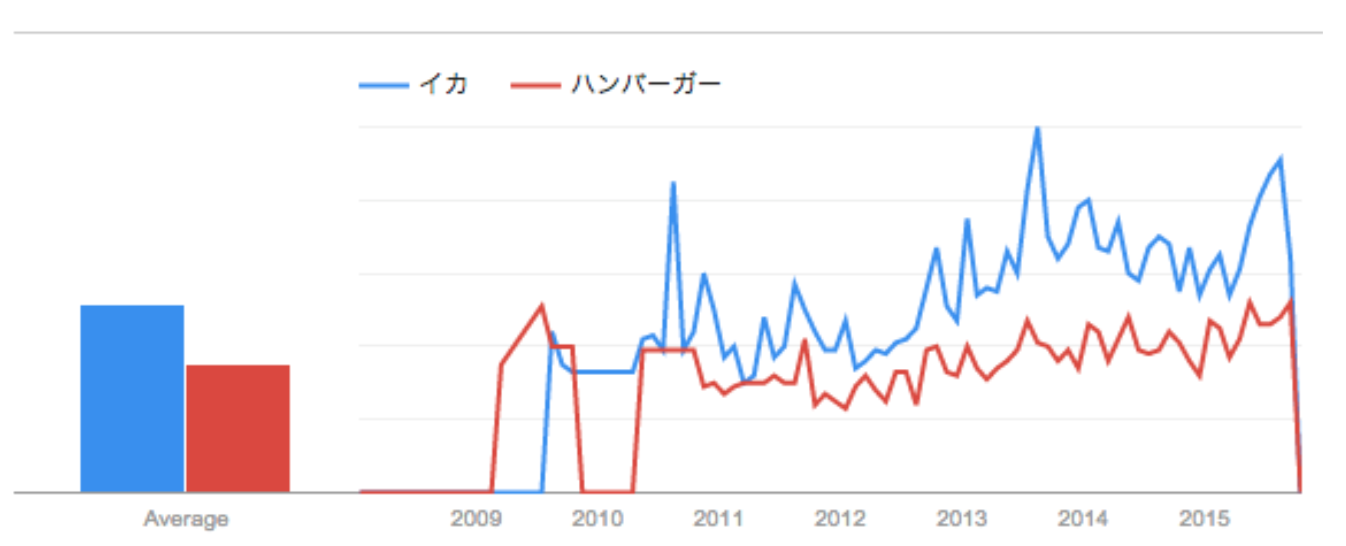
Google Image searches of squid vs. hamburger over time, in Japanese, Google Trends.
Davis jokes that the Emoji Subcommittee is a “cabal,” because he doesn’t think it is—a cabal has secrets, plots, and intrigues, whereas the committee has rules, methods, and graphs. Yet I couldn’t help but see “squid vs. hamburger” as a thin veneer covering over the fact that Unicode is now in the business of a speculative design process involving the affective potential of digital communication for millions of people.
Some Unicode members are disgruntled with its newfound power. “Unicode is serving as the emoji gatekeeper,” said Markus Scherer, one of the original authors of the Unicode Emoji proposals. “How do we get out of that business?” Other Unicode members don’t seem to mind their power: “The one ring to rule them all,” Davis responded to Scherer, sarcastically citing the Lord of the Rings prop used to gain dominion over the masses.
What’s more, I learned, this is capitalism. The Emoji Subcommittee decides which emoji live and which die by making recommendations to the Unicode Technical Committee. In typical woo-woo California style, the committee makes decisions based on consensus voting, but you have pay your way into voting rights: full members pay $18,000 a year for the right to vote.[4] As a result, the membership is comprised of corporations like Apple, Facebook, Google, IBM, and, less predictably, the Ministry of Endowment and Religious Affairs of the Sultanate of Oman. And this is nation building. India joined the Unicode Consortium in 2000;[5] afterwards, the Indian state of Tamil Nadu joined independently as a polite Eff you to India and to add fuel to a dispute they were having over whether to encode Tamil as a syllabary language (as was commonly being taught to schoolchildren in the state) or with the Brahmi-based encoding model of greater India.
For its annual conference, the Unicode Consortium tries to avoid such politics whenever possible. An IUC Conference committee member took Maggie and I out to dinner in the hotel lobby one night. He wore tan keens, kept tiny bifocals in his shirt pocket, and delivered sweet and practiced lines (“I’ve been working at this job since 6 months before September 11th!”). He told me that the one political proposal submitted a few years ago—standardizing Southeast Asian languages—had been turned down by the conference committee. “Why did you accept our talk?” Maggie asked. “Artists want to come talk at Unicode?! About social issues?! We want them,” he responded.
Other talks had deliciously titled slides: “Noto script support in Marshmallow” for Android Typography advances, or “Enhanced Umm al-Qura Calendar Support” for using the lunar-based Hijri calendars of Saudi Arabia. Over lunch I conversed with an internationalization engineer who hung his backpack on the back of his chair, then clipped the waist strap around the chair’s base as if for maximum utility. He demoed the blinkies on his backpack straps—extra security for pedestrian safety in Palo Alto.
Extra security measures for pedestrians on the backpacks of IUC39 conference attendees, 2015. Vine by Liat Berdugo.
All of us oddballs at the Unicode conference were there because of emoji. "Actually, the only thing weird about you," said SIL International engineer Martin Hosken to me, over a cannoli, "is how utterly normal you are. We're the weird ones." Hosken goes to Unicode because of bibles. He works at the so-called "script boundary" between Thailand and Laos, where the same spoken language is written with a different script. In order to spread the gospel, someone either has to retype the entire New Testament, or hire Hosken to write a script translator. I looked down to the floor and saw where the carpet pattern abruptly changed. Script boundaries, carpet boundaries: all the divisive elements in one hotel.
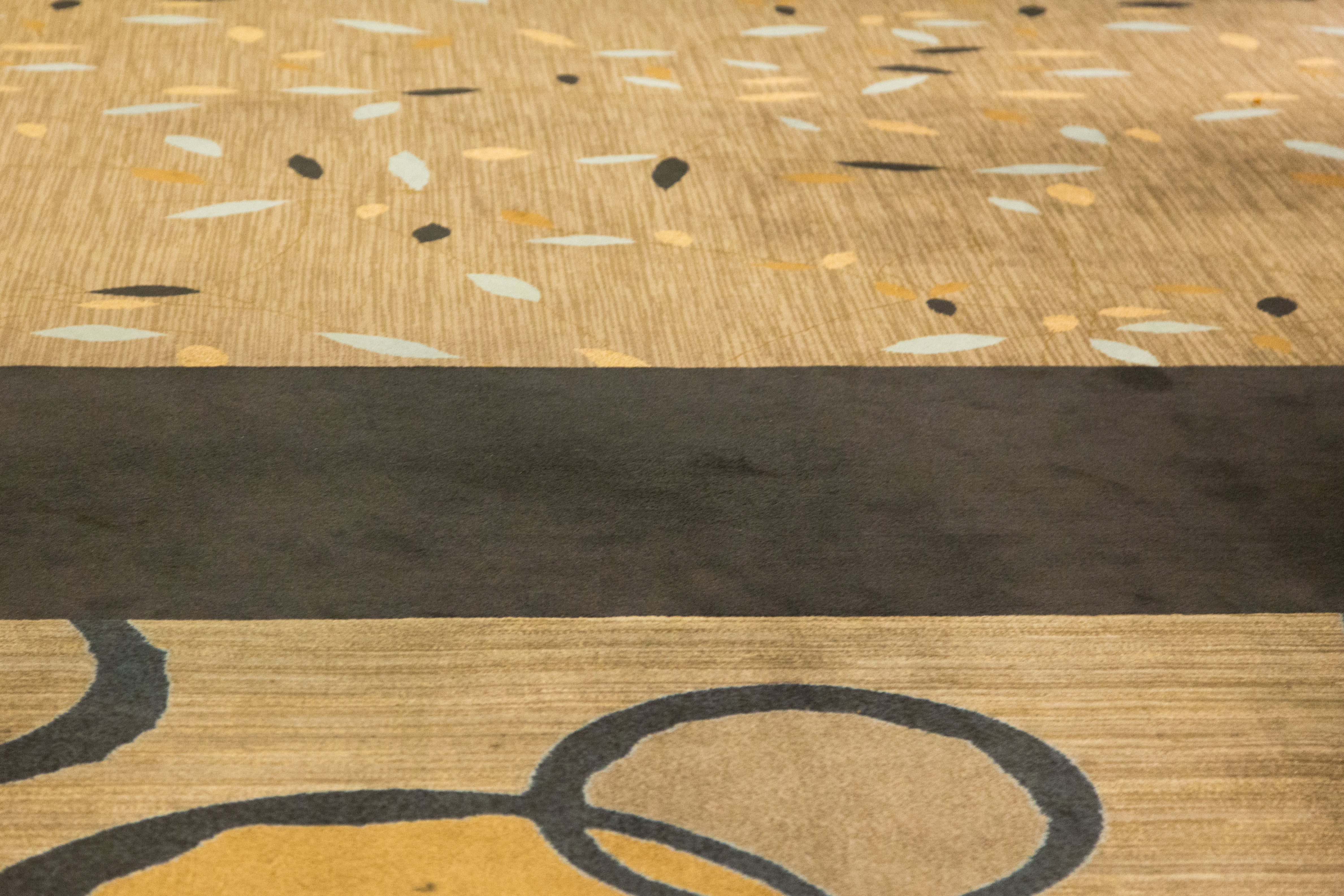
Carpet boundaries at the Hyatt Regency formed the backdrop to the 2015 Internationalization and Unicode Conference, 2015. Photo by Liat Berdugo.
So this was Unicode: sometimes the stakes are high, and sometimes they are low. The high stakes come with serious questions about inclusion and representation. For instance, with the release of emoji skin color modifiers in 2014, the world was offered five new tones ranging from dark brown to pink. The default skin tone was then set to be an inhuman yellow, “similar to Homer Simpson or John Boehner,” noted Davis at the conference. The world now had a Black Santa. But when Instagram released its Emoji Hashtags, allowing search by emoji for the first time ever, it decided to keep all skin tones separate. A search for #![]() pulls up different results than #
pulls up different results than #![]() . The result? A racially segregated Instagram.
. The result? A racially segregated Instagram.
The last conference session I attended was on the topic of emoji search, but the Instagram search issue did not come up; the stakes were much lower. In the Q&A, a man in a black polo shirt embroidered with "NETFLIX" raised his hand and stated: “I would like to know what happens if you go to Yelp, and search for the smiling pile of poop.” A Yelper in the audience—who had hand-written search terms for 826 emoji—answered, “I can tell you that the pile of poo emoji maps to the English word, ‘poop’."
We had been readied for this moment. Nova Patch, the Shutterstock engineer leading Emoji Search, had given us our raison d'être: “Why do emoji search?” he asked rhetorically. “Well, because it’s there!” he exclaimed. This was not about morals, nor about money, nor about efficient uses of time. This was about one of the golden rules of programming: people will always put unexpected inputs into data forms. An engineer’s job is to anticipate that. “I can make that happen,” Patch said. He typed “💩” into the Yelp search bar. And so there we were, all staring at the phone number for the pet sitting service called POOP 911. “Congratulations,” he said, “on giving a lot of attention to emoji searching.”
Sometimes the more attention a thing gets, the more it deserves. Sometimes it’s just the opposite. And sometimes a sort of narrow, professional instrumentalism takes hold—biasing a restricted point of view in favor of a broader one. It is that broader view that might one day accommodate the culturally critical questions of inclusion, representation, and implications of standardization within technical discussions. But this—this was Maslow’s law of the instrument, emoji-style: if all you have is a search box, everything looks like 💩.
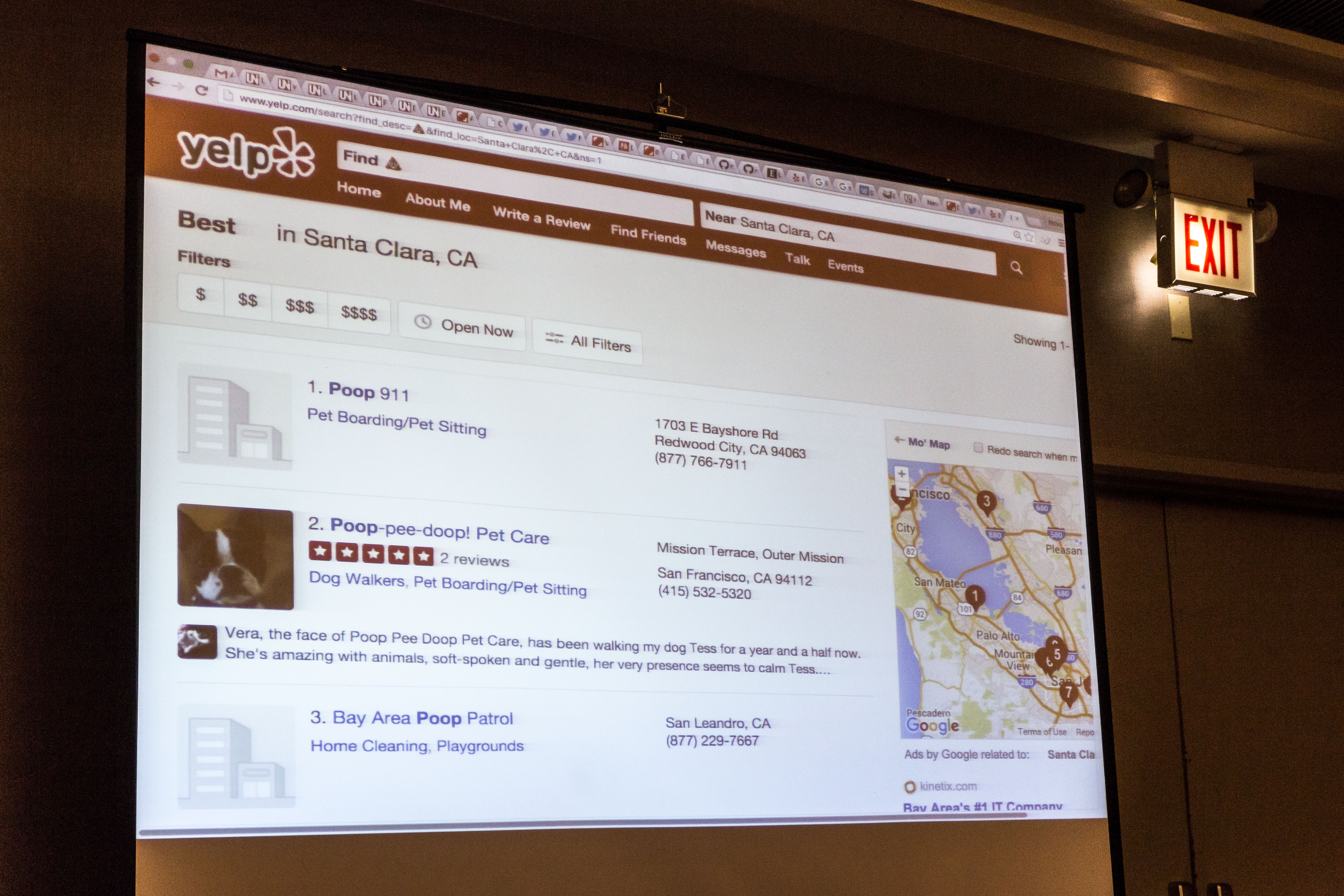
Finding 💩 near Santa Clara, CA during the “Emoji Search” Panel at the 39th Internationalization and Unicode Conference, 2015. Photo by Liat Berdugo.
Notes:
[1] Technically, ASCII was rolled into the Unicode Standard as a proper subset. All ASCII is in Unicode, but not all Unicode is in ASCII—not by a long shot. This great release was followed by John Dvorak’s potty-mouth-titled article, “Kiss your ASCII Goodbye,” in the September 15 1992, issue of PC Magazine (p. 93).
[2] As Stark and Crawford noted in their recent article “The Conservatism of Emoji: Work, Affect and Communication”, emoji “act symbolically as signifiers of affective meaning.” http://sms.sagepub.com/content/1/2/2056305115604853.full.pdf+html.
[3] Referencing a quote from a Dazed article by Thomas Gorton to the same effect (http://www.dazeddigital.com/artsandculture/article/22660/1/unicode-consortium-announces-37-potential-new-emojis)
[4] For full details on voting methods, see Unicode’s “Technical Committee Procedures for the Unicode Consortium”. For full details and pricing structures, see Unicode’s “Membership Levels and Fees”.
[5] See Unicode’s "Membership History" for full details on members of the Unicode Consortium.
